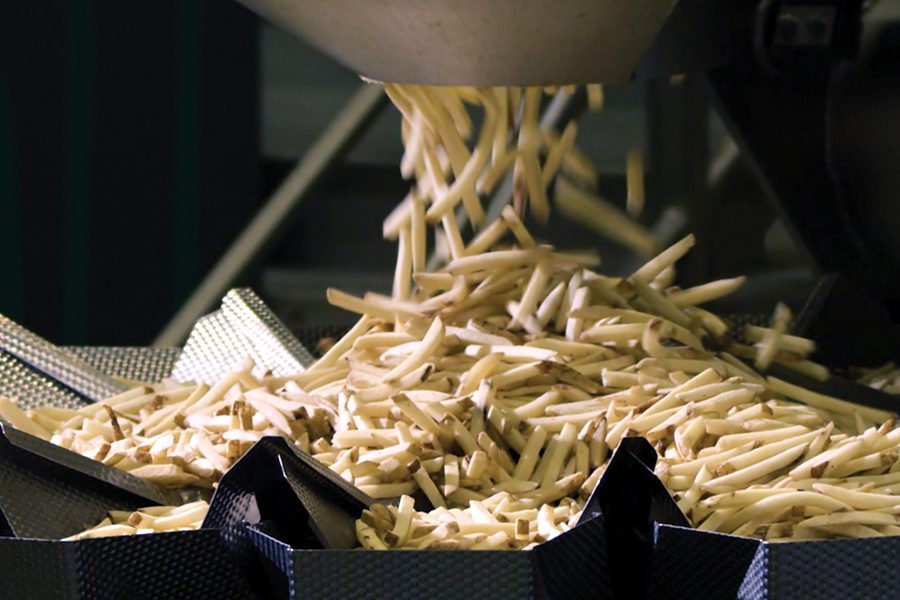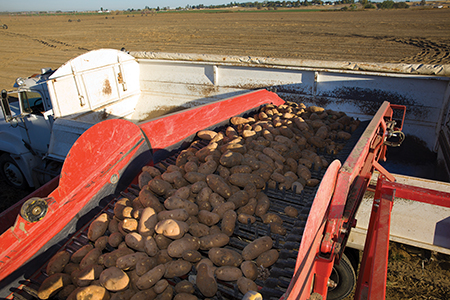
Home » Growers look to Mexico for export recovery
Growers look to Mexico for export recovery

June 14, 2021
In 2020, Washington potato growers faced a staggering surplus of potatoes.
In 2021, they’re banking on a revival of the food service industry, including in-person dining, improved shipping conditions and a just-opened Mexican market to help reverse the chaos left by the trade wars and Covid-19 pandemic.
The pandemic brought restaurant dining to a standstill starting in Asia in January 2020, leading processors to cancel orders for Mid-Columbia spuds.
The Washington Potato Commission predicted growers and potato sheds would be forced to throw away a billion pounds that would not be used – one-tenth of Washington’s annual potato crop.
“We were giving away potatoes left and right,” recalled Chris Voigt, executive director.
Fears that a billion pounds of potatoes would be discarded were unfounded. A Midwestern freeze led to demand from processors in North Dakota, good news for Washington producers if not their Midwestern peers.
The final loss: 300 million pounds.
Potatoes are Washington’s third largest crop with a pre-pandemic value of $934 million, according to the Washington State Department of Agriculture. About 90% is processed into frozen french fries and other products, and 70% is exported, chiefly in the form of frozen french fries.
In 2020, frozen fry exports were worth $784 million, down about 11%, thanks to falling demand from restaurants, cafeterias and other “food service” customers, according to Department of Agriculture figures finalized in May 2021.
Japan, South Korea and Taiwan were the leading buyers of Washington-produced fries, according to the state. The Philippines, normally in the top three, fell off during the pandemic.
Potato chip makers in Japan and South Korea began buying chipping potatoes from the U.S. about five years ago.
Going into 2021, the picture is improved.
“We’re not quite back to where we were pre-pandemic, but we’re getting closer,” Voigt said.
Russets dominate
Under normal conditions, the russets grown in Washington are sold to processors such as Lamb Weston Holdings Inc. or on the fresh market.
In April 2021, Lamb Weston, which is publicly traded, reported net loss of 4% in the third quarter but noted that through March 28, 2021, North American shipments were at 90% of pre-pandemic levels, European ones were at 85%, and “other” international shipments were at 75% compared to 2020.
Russets dominate the state’s potato crop.

The pandemic appears to be receding as an economic force. Washington state is expected to fully reopened in June 2021, with restaurants and retailers able to operate at full capacity after a year of shutdowns and restrictions.
Nationally, the picture improved enough that the Centers for Disease Control said it was OK for people who had been vaccinated against coronavirus to stop wearing face masks under some circumstances.
But the outlook is not all cheery for 2021. In May 2021, potato prices were low, below the cost of production.
“But at least we are not giving them away for free,” said Voigt, who said he was “a notch above” being cautiously optimistic about the coming year.
“You wouldn’t be in farming if you weren’t an optimist in the spring,” he added.
Stored potatoes
Washington grows potatoes on about 270,000 acres – its maximum capacity given land and water constraints. Potatoes can only be grown on a site every four years because of pest issues, and the crops must be irrigated on both sides of the state.
About 90% of potatoes grow in the Columbia Basin stretching from the Tri-Cities to Moses Lake and Quincy.
In a typical year, the vast potato sheds that dot the region run out of potatoes harvested the year prior around the Fourth of July. Potatoes harvested between July and September go straight to processors. Those harvested later go into the warehouses and the process starts up again in the coming year.
Growers and processors typically begin signing contracts in September for the following year’s harvest.
Of course, 2020 was not normal.
“We still had potatoes in storage until the first of October,” Voigt said.
He doesn’t expect a return to normal in 2021, saying export slowdowns related to container shortages could help push the date sheds run out of stored potatoes to early August. Under the right conditions, a potato can be held for about a year before being processed.
The container shortage is another symptom of the pandemic. Consumer spending shifted to ordering online, leading to an avalanche of Asian products making their way to U.S. ports by ocean carrier. It’s so lucrative that shippers send the containers back empty rather than routing through U.S. exporters.
“They really are not interested in hauling frozen french fries,” Voigt said.
Mexican market
While markets normalize and consumer spending shifts back to spending on restaurants and services, there’s a lucrative spot on the potato horizon: Mexico.
On April 28, 2021, the Mexican Supreme Court issued a 5-0 decision that opens the market to fresh U.S. potatoes in a long-running case over the role of its federal government in establishing trade regulations. U.S. potatoes had been banned beyond a 16-mile stretch along the U.S. border since 1996 over concerns about plant disease.
The ruling follows decades of litigation following a 2002 agreement that opened the U.S. market to Mexican avocados and the Mexican one to potatoes. Full access was supposed to begin in 2014 but was challenged by the National Confederation of Potato Growers of Mexico, according to the Idaho Farm Bureau.
The National Potato Council estimates exports of fresh potatoes to Mexico will grow to $200 million, from the current $60 million.
Idaho may be the nation’s leading potato grower, but Washington is No. 2.
“That’s huge,” Voigt said. “We have a better-quality potato. If you were to buy a red potato in Mexico, it’s a white potato that’s been sprayed red.”
Focus Magazine Agriculture + Viticulture
KEYWORDS june 2021





